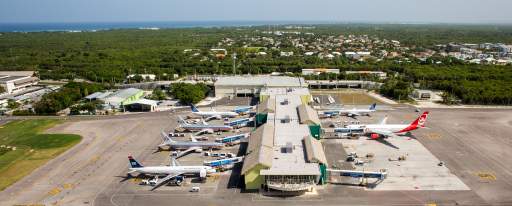Air + Sea Travel
The Dominican Republic boasts eight international airports, five cruise destinations, a variety of marinas for boats and yachts, and domestic airstrips for private planes and charters.
Wherever you are headed in the DR, by air or by sea, choosing the right gateway is key. This is a large island, with road distances often too great to cover in a single day. For example, traveling overland between the Punta Cana and Puerto Plata airports can take up to seven hours. Picking the right arrival and departure gateway closest to your final destination is therefore crucial, and will save you time and money.
As your trip progresses, you can transfer at your leisure to other parts of the island by car, bus, or charter plane. Know your options and see multiple DR regions in one trip.
International Airports:
Santo Domingo
Las Américas International Airport (SDQ) –also known as José Francisco Peña Gómez International Airport–is located 30 minutes from the capital of Santo Domingo, and is the city’s main point of entry for international air arrivals. SDQ is also convenient to the tourist beach towns of Boca Chica and Juan Dolio, starting just six miles away.
La Isabela International Airport (JBQ) –also known as Dr. Joaquín Balaguer International Airport– is located north of Santo Domingo, and handles flights to Haiti, Cuba, and select neighboring Caribbean islands.
Punta Cana
Punta Cana International Airport (PUJ) is a 15-minute drive from the Punta Cana and Cap Cana areas, a 30-minute drive from Bávaro, El Cortecito, and Arena Gorda, and a 45-minute drive from the Macao and Uvero Alto areas. Offering direct flights from over 28 countries and 96 cities around the world, this is the busiest airport in the Dominican Republic and the second busiest in the Caribbean region, with nearly 3.5 million international passenger arrivals every year.
Puerto Plata
Gregorio Luperón International Airport (POP) is conveniently located 20 minutes from the north coast city of Puerto Plata, and near neighboring tourist destinations such as Cofresí, Playa Dorada, Sosúa, and Cabarete. It is also convenient to Playa Grande and Río San Juan, an hour away by road.
La Romana
La Romana International Airport (LRM) –also known as the Casa de Campo International Airport–is strategically located on the southeastern coast, a mere 10-minute drive from Casa de Campo Resort & Villas, and a 20-minute drive from Bayahibe. The airport is also less than two hours’ drive from Santo Domingo, and less than an hour’s ride from Punta Cana.
Samaná
El Catey International Airport (AZS) – also known as Juan Bosch International Airport –sits half an hour away from the city of Santa Barbara de Samaná, 30 minutes from Las Terrenas, and just an hour’s drive to Las Galeras.
Santiago
Cibao International Airport (STI) is 15 minutes from bustling Santiago, the second largest city in the Dominican Republic, tucked in the mountainous center of the country. It is closest to the nearby cities and towns of La Vega, Jarabacoa, and Constanza. It can also be a second gateway option if you are staying in Puerto Plata–just ensure additional transportation time before your return flight.
Cruise Destinations:
The Dominican Republic boasts the highest number of cruise destinations in the Caribbean: Santo Domingo, La Romana, Puerto Plata, Samaná, and Punta Cana. In 2017, 533 cruise ships and more than 1,100,000 passengers visited from Miami, Tampa, and Fort Lauderdale, among other hubs.
Santo Domingo
The world-class Santo Domingo Port has a privileged geographic location, nestled at the mouth of the Ozama River, where it meets the Caribbean Sea. The entrance leads into this first-ever colonial settlement in the Americas via two state-of-the-art terminals: Don Diego and Sansoucí.
La Romana
Two cruise port facilities benefit the east coast, where the Romana River meets the Caribbean Sea. The modern and picturesque Casa de Campo Port is located near Casa de Campo Resort, and the anchoring facilities of Catalina Island, where passengers are transported to the island to enjoy the breathtaking white sand beaches, and world-renowned Pete Dye-designed golf courses.
Samaná
A short distance from Miami, the Samaná Peninsula–the DR’s secluded beach haven–is conveniently located along the route of major Caribbean cruises. Making it a port of call gives cruise lines great flexibility in scheduling vessels along the eastern and southern Caribbean’s often crowded routes. The Samaná Peninsula’s cruise terminals are located on Cayo Levantado, and in the Bay of Samaná.
Puerto Plata
Located on the north coast, along the scenic Bay of Maimón, the Amber Cove Cruise Center sits in the heart of the ecotourism and water sports hub of Puerto Plata. Its easy access and proximity to surrounding destinations and attractions make it a popular cruise destination pick.
Punta Cana
Visitors to Marina Cap Cana, located in the popular Punta Cana area of the Dominican Republic, get to enjoy the east coast’s clear coastal waters, renowned for golf, deep sea sports fishing and diving. The marina and nearby hotels also offer plenty of entertainment, from gourmet restaurants to upscale boutiques.
Marinas:
The Dominican Republic’s coastline is one of the most expansive and diverse in the Caribbean, stretching over 1,600 kilometers (1,000 miles). The coastal landscape is one of lush mountains punctuated by coconut groves, valleys and plains, white sand beaches facing turquoise waters, and offshore coral reefs. In the last few years, the country has more than doubled its number of full-service marinas–a handful of which offer groundbreaking features previously unavailable in the Caribbean–available to boaters, sports fishers, and yachters.
The Arrival Process
Upon arrival at an authorized entrance port, you can expect:
- A potential boat check by the Marina de Guerra or Coast Guard, M-2 (Intelligence), and the Department of Drugs. They reserve the right to board your boat and inspect it. If they do, they may ask to check below deck. There is no charge for their service, as the marinas cover for the cost of their presence; and
- A boat visit by Immigration to stamp the crew’s passports–there is usually a set fee for this per boat. In addition, there is a US$10 tourist card fee per arriving passenger, valid for 30 days.
Note that moving the boat to another official entry harbor requires advance clearance–also known as a despacho. This is given at no charge, but it has become customary to tip the Coast Guard for the service.
Some marinas may also assess charges pertinent to the harbor, such as refuse disposal, or a harbor anchoring charge. Contact your chosen marina for details.
Anchoring
Boaters may anchor along the way, with a valid reason, before arriving at their next official harbor or despacho. Each boat must show papers to the official that will come out to visit after anchorage. There is no charge for this service, but a small tip to the official and to the captain bringing him out to the boat is considered customary.
Choosing a Marina
From the Punta Cana shoreline to the Samaná Peninsula, Santo Domingo, La Romana, or the north coast of Puerto Plata, find the marina that meets your needs and fits your personality.
Marina Cap Cana is the most modern facility in the Caribbean, offering wet slips and handling yachts up to 150 feet long. The 370-acre marina is popular among fishers for its surrounding deep waters immediately teeming year-round with blue and white marlin, sailfish, wahoo, and tuna.
PUNTACANA RESORT & CLUB MARINA
This full-service marina is located at the Puntacana Resort & Club, home to luxury hotels, restaurants, and outdoor attractions. With two docks and mooring for 43 yachts up to 65 feet LOA, the marina is one of the most popular locations for hosting billfish tournaments.
Located at the mouth of the Chavón River where it meets the Caribbean Sea, Casa de Campo Marina is one of the most prestigious marina facilities in the Caribbean. Extending more than 90,000 square meters (0.03 square miles), with a total of 370 slips, this large capacity, upscale marina accommodates ships from 30 to 250 feet in length, in addition to guest sailboats. There’s a colonial-style Yacht Club on site, hosting numerous events, a marine boulevard with international restaurants, a piano bar, shopping plazas with a fishing club, and a dive center.
Part of the Sansoucí Santo Domingo Port, this small marina boasts panoramic views of the Colonial City. It offers parking space for up to 29 boats, and 33 moorings for medium length vessels. On site are immigration and customs authorities, and shower facilities.
Just past the private Club Náutico de Santo Domingo, Marina Zar-Par is located in the Bahía San Andrés, in the beach town hub of Boca Chica, and offers 150 slips. Conveniences include free Internet, a waterfront restaurant, laundromat, and free rides into the town of Boca Chica for errands.
OCEAN WORLD ADVENTURE PARK & MARINA
West of Puerto Plata, in the nearby beach town of Cofresí, Ocean World Adventure Park runs a marina adjacent to its interactive recreational park. The full-service facility has more than 100 slips, with the capacity to dock yachts of up to 250 feet LOA. The 35-acre complex also offers various services ranging from laundry to car rentals, and casino entertainment.
Puerto Bahía is a full service marina on the north end of Samaná Bay, on the northeastern coast of the DR. It provides slips of up to 150 feet LOA, and boasts nearby natural treasures such as Cayo Levantado island and Los Haitises National Park, not more than 11 nautical miles away, aside from numerous beaches along this gorgeous coastline. Services include Internet access, personal concierge service, pool area, bars, restaurants, a gym and spa, mini-market, and other basic services.
PUERTO BLANCO MARINA
West of Puerto Plata, in the coastal town of Luperón, Puerto Blanco is a fully enclosed marina with the ability to moor 200 yachts with drafts up to eight feet. The marina is popular for hosting lively nights with Dominican food, merengue dancing, and weekly karaoke, for those docking their yachts here. The Luperón harbor is known for being a safe zone for yachts during hurricanes and tropical storms.












